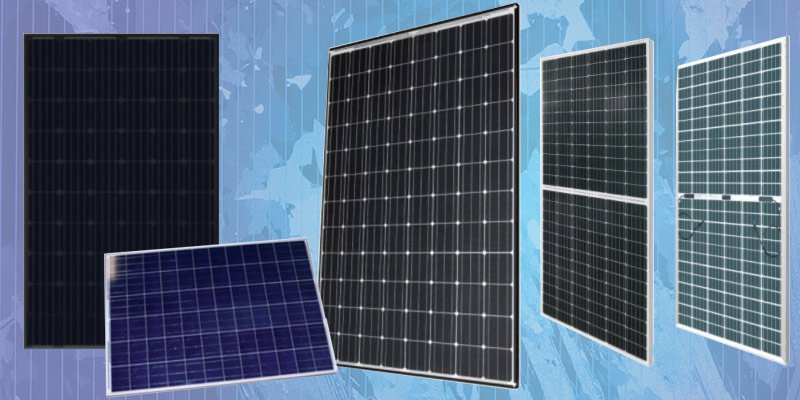Choosing the right solar panels for your project is an important step in creating a long-lasting, money-saving system as far as overall electricity cost is concerned, in addition to reducing carbon footprint or emissions that harm the environment.
Assuming that you have had your energy requirements assessed by a professional particularly a solar electrician, (NB: This is important in that it will help you find a middle ground so that you do not end up buying a system that does not meet your power needs or paying more for what you do not actually need.), below is a list of what you should pay attention to so as to select the best solar panels for your project.
-
Panel Type
There are three main types of solar panels i.e. monocrystalline, polycrystalline, and thin-film or amorphous panels. Which one you choose will have an impact on the overall look of your system, its cost, the electricity produced, and the total space it takes up.
Monocrystalline panels have a darker tint and are more efficient, which means you can produce more electricity with fewer panels, and therefore your overall system takes up less space. With all their advantages though, monocrystalline panels are often more expensive.
Polycrystalline panels on the other hand have a bluer tint and are less efficient compared to monocrystalline panels. This means you’d need more panels to generate the same amount of electricity and also more space. They come at a lower price compared to the Monocrystalline panels.
Lastly, amorphous silicon panels are the victors when it comes to form-factor compared to monocrystalline and polycrystalline panels, but they’re not known for being efficient. Portability and flexibility are two of the major drawbacks of this type of solar panel and you require way more panels and space to generate the same amount of electricity as their predecessors. They are the cheapest of all.
-
Panel Color
This takes into account the color of the back sheet (the outermost layer of the solar panel that can be seen through the gaps between the solar panel cells) and the frame of the solar panel.
Some manufacturers offer solar panels with black back sheets instead of white. The former creates a more uniform-looking panel that blends into darker roofs, however, they hold heat, and so they may get hotter than traditional panels (with white back sheets), which could slightly reduce the panels’ efficiency.
There are also two options when it comes to the color of the metal frame around the borders of the panels, which are black and silver. Black frame panels tend to be more aesthetically appealing but cost more than their counterpart. Aside from that, they both (black- and silver-frame panels) perform the same.
- Solar Panel Size
Solar panels come in different sizes. This takes into account the number of cells (the small, crystalline silicon wafer) on the solar panel which translates to the panel’s power output and its physical size.
Let’s take an example of the 72 & 60 cell panels.
The 72 cell panels are, on average, about a foot longer than 60-cell panels. Their larger size makes them better suited for large, wide-open spaces like commercial roofs and ground mount systems. 60-cell panels on the other hand are better suited to fit in tighter spaces.
Overall, 72-cell panels generate more electricity per panel compared to the 60-cell panels.
-
Panel Production
This takes into account the output rating and efficiency. The output rating is the number that represents how many watts of electricity the panel will generate under ideal conditions. Higher wattage means more electricity generated per panel, but it will likely translate to a higher price tag.
The panel’s efficiency on the other hand is the percentage of electricity it produces from the energy it receives from the sun. The more efficient a solar panel is, the more kilowatt-hours of electricity it will produce. This is especially important if you’re concerned about the amount of space your solar system takes up.
Let’s take for example two 300-watt solar panels-one with 21% efficiency and another with 17% efficiency. Both will produce 300 watts of power under ideal conditions but the one with higher efficiency will be physically smaller and take up less space than the one with less efficiency.
Also Read: The Benefits Of Ground-Mounted Solar Panels
-
Warranty
A robust warranty is an indication of overall panel quality. Many high-quality solar panels are guaranteed for 25 to 30 years and can continue working even after their warranty expires depending on how well you take care of the panels.
Making sure you purchase solar panels that will stand the test of time is essential to the long-term success of your system, and the longer your solar panels generate electricity, the more money you save.
-
Overall Quality
The quality of the solar panel is determined by the manufacturer mainly in how the product is manufactured and the quality of the materials used in the process. Before you settle on who to buy the solar panel from it is wise to check the companies’ reviews or history and see what experiences clients had with each of them.
Since you will make a big investment, it is important to do a bit of research and see if clients are satisfied with the product and the customer service and if the company delivers its promises.


